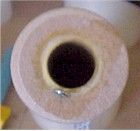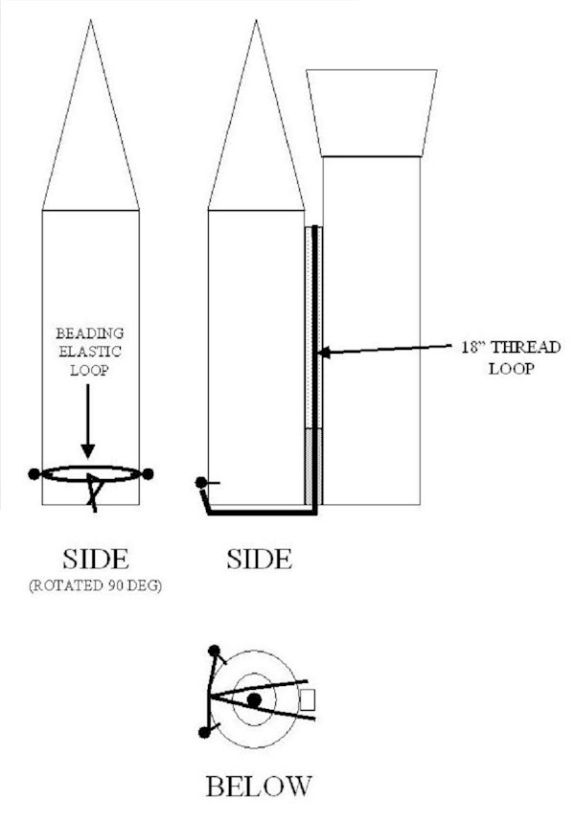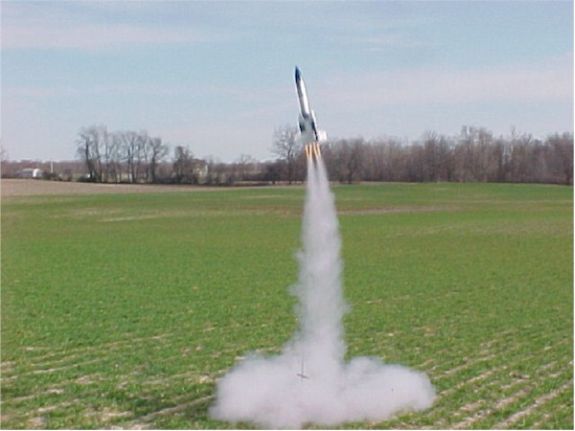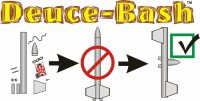Modification Deuce-4 Heavy Payloader Modification
Modification - Deuce-4 Heavy Payloader {Modification}
Contributed by Mark Schrader
| Manufacturer: | Modification |
The following article was a submission to the FlisKits, Inc Deuce-Bash Contest and is archived with permission from FlisKits. Some of these designs are not actually kitbashes, however, all come from the basic motor design feature of the FlisKits Deuce's Wild.

Brief:
Attached is my Deuce Bash entry. Please let me know if you need any other information. The inspiration for this design came from the Boeing Delta-4 Heavy and Lockheed-Martin Atlas-5 heavy lift rockets. It is basically a conventional Deuce with the addition of a 10-inch payload section and two conventional parallel boosters. The payload section has a four-inch parachute bay aft. The parallel boosters separate after motor burn out and recover on 12-inch parachutes. At liftoff they are positively attached until motor ignition using a unique method. In the event of no ignition or late ignition, the boosters are held in place for safety.
Construction:
Sustainer:
The sustainer consists of a 7.5 inch piece of BT-60 from a Baby Bertha and the Deuce canted twin 18 mm motor mounts. On top of this is a balsa 1.5-inch T60-70 transition from the parts box. I hollowed this out with a Dremel tool and glued a motor spacer tube inside to duct the ejection gases. I used a ¼ inch screw eye at the top of the balsa transition to anchor the recovery system.
I use 6 inch lengths of styrene plastic square stock to retain the parallel boosters. After drilling small holes in the plastic and roughing up the body tube with sandpaper and a #11 blade, I attached the plastic stock with 90-minute epoxy.


Payload Bay:
The payload bay is a 10-inch piece of BT-70 tube and the nose cone is a balsa tube I got in an eBay auction lot. I glued an Apogee Components bulkhead and centering ring four inches from the bottom to create a parachute bay. I glued a loop of 300lb Kevlar line to the bulkhead with 90-minute epoxy to which I would attach the recovery system.

Parallel Boosters:
The parallel boosters consist of 6 3/4 inch lengths of BT-60 from a Patriot kit, two Deuce nose cones (one from the kit and one from my Secret Santa parts package), and two motor mounts (again from Secret Santa package). The motor mount is installed so that the motor will be flush with the bottom of the booster when launched. More about this when I describe the booster retention system.
The key feature of the boosters is the mounting system. The mounts consist of two-inch pieces of plastic stock which nest inside the plastic stock on the sustainer. The two-inch stock is mounted on a one inch piece of sheet styrene stand off that is the same width and thickness as the square stock.


Launch Lug Alignment:
I used 3/16 inch launch lugs. The upper lug is glued to the BT-70 tube and the lower lug is glued to the fin as shown below.
Body Tube Wrap:
The payload tube is finished with a wrap of white label paper. I used MS PowerPoint to create a 10" X 7" box in which I placed the graphics. NASA for obvious reasons, FlisKits the prime contractor, Boeing and Lockheed Martin the subs, Apogee for component and simulation support, and Estes for propulsion. The BT-70 tube has a circumference of seven inches so this went relatively easy.

Booster Retention System:
The most unique feature of this model is the positive retention system designed to keep booster attached in the event that they light late or not at all. The system consists of two wire nails inserted into each booster, CA'd and epoxy puttied into place. I then tie a small loop of beading elastic to an 18" loop of sewing thread. The thread is attached to the top of the styrene stock on the sustainer, led under the booster, and the beading thread loop is attached to the two nails. The elastic takes the slack out of the thread loop and holds it in place until the motor exhaust burns through the thread. I attach the thread-elastic loops with the motor in place and run the thread beneath the nozzle and hold it in place with the plastic ignitor cap. Motor thrust holds the boosters in place and at burn out they fall away and deploy 12 inch mylar parachutes.

Flight and Recovery:
First flight was on a pair of central C6-7s and C5-3 motors in the boosters. Boost was moderately slow and the rocket turned slightly into the 5-8mph breeze. The long burn of C5-3s kept the boosters attached until near apogee and they separated and deployed their chutes. The C6-7 delay was a little too long as the sustainer arched over and headed down. Ejection was a couple seconds after apogee and the 24-inch mylar cute brought the sustainer to a good landing. The only damage was a chip from one fin due to landing on hard turned earth. For the next flight I'll use C6-5s and B6-2s.

Summary:
Although I didn't use all the parts that came in the Deuce's Wild kit, I did launch the parts I didn't use in the payload compartment.
#Related Reviews
- Deuce's Wild to Deuce-XL5 By Dick Stafford
After seeing various Deuce bashes on The Rocketry Forum and elsewhere: eugenefl's fighter, sandman's DynoSoar, a super-roc version, and most recently an egg-loft version flown at NARAM, I decided to build a Deuce-XL5 to go with my 29mm and MMX Fireball XL5s. My design constraints included keeping ...
- FlisKits 29mm Upscale Deuce's Wild! By Mike Reese
The following article was a submission to the FlisKits, Inc Deuce-Bash Contest and is archived with permission from FlisKits. Some of these designs are not actually kitbashes, however, all come from the basic motor design feature of the FlisKits Deuce's Wild. I made this upscale ...
- FlisKits U.S.S. Deuce's Wild By Justin Cartisano
The following article was a submission to the FlisKits, Inc Deuce-Bash Contest and is archived with permission from FlisKits. Some of these designs are not actually kitbashes, however, all come from the basic motor design feature of the FlisKits Deuce's Wild. Here's my entry, ...
- Scratch Deuce Jr. By Matthew McFarland
The following article was a submission to the FlisKits, Inc Deuce-Bash Contest and is archived with permission from FlisKits. EMRR hopes that these kitbashes inspire our guests to get creative and share your kitbashes, on FlisKits rockets or any other manufacturers, with EMRR. I logged ...
- Scratch Deuce's Wild Payloader By Allan Lovering
The following article was a submission to the FlisKits, Inc Deuce-Bash Contest and is archived with permission from FlisKits. Some of these designs are not actually kitbashes, however, all come from the basic motor design feature of the FlisKits Deuce's Wild. Parts list: 1 ...
- Scratch Dos Kraken By Andrew Hansom
Dos Kraken is a combination and upscale of two unique rockets. The design is from Pemtech's Kraken with the sculpted tube fins and the canted twin motor tubes design was borrowed from FlisKit's Deuce's Wild. Dos Kraken will fly on a pair of 38mm x 480 AT motors with the total output of a J sized ...
- Upscale FlisKits Deuce's Wild (24mm) By Lance Alligood
This is a 24mm upscale of the (justifiably) insanely popular FlisKits Deuce's Wild! All of the key parts used in this build (the motor mount, body tube, and nose cone) were ordered directly from FlisKits as well. It is built to use all sizes of available and popular 24mm motors. I ...
Related Products
Sponsored Ads
 |
 |












